
The Rocca Maggiore is a castle which dominated, for more than eight hundred years, the city of Assisi and the valley of Tescio, constituting their principal defensive fortification.

The Rocca Maggiore is a castle which dominated, for more than eight hundred years, the city of Assisi and the valley of Tescio, constituting their principal defensive fortification.

It ws built in 1316, and omprises two fortresses, Major and Minor.

The first document regarding the fortress dates back to 1173, when the German diplomat and Catholic Archbishop Christian of Mainz (1130 - 1183, chancellor of Germany during the reign of Emperor Frederick I Barbarossa, occupied Assisi on behalf of the sovereign who stayed there for a short time. [1]
The young future King of Sicily and Emperor Frederick II also lived there, entrusted by his mother Costanza d'Altavilla to the Duchess of Urslingen, wife of Duke of Spoleto and comes Assisi Corrado, confidant of the monarch Swabian. [2] [3]
Queen Empress Constance returned to Sicily and then return to Assisi with the wife Henry VI: the baptism of Constantine was celebrated in Cathedral of San Rufino and was imposed the auspicious name (of the two grandparents) Frederick Roger. [4]
In 1198, the city passed to the Guelphs of Pope Innocent III, and the people, causing extensive damage to the fortress, drove out the imperial legate and Frederick, who was only four years old. In that year, Francis of Assisi was sixteen. [5]
The fortress was reconstructed in 1356, on the initiative of Cardinal Albornoz (1310 - 1367), who had been commissioned by Innocent VI by Avignon, to strengthen the fortifications of the Papal States.
In 1458, the captain of Perugia and Lord of Assisi Jacopo Piccinino (1423 - 1465 built the polygonal tower north - occidentale, which was then finished by Pope Pius II, and connected to the rest of the walls with a fortified and defensible corridor. The complex consists of fortress walls built with the pink stone of Mount Subasio, trapezoidal, with towers at each corner, which includes square formwork, renovated in 1478 by Sixtus V, on which stands the keep. [6]
The inside of the fortress (where, in 1972, some scenes of the movie "Brother Sun, Sister Moon", directed by Franco Zeffirelli were shot), [7] )leads to the entrance of the round bastion, commissioned in 1535 by Paul III. There is a large fenced yard, whih contained service rooms, and the mole, former home of the castle, divided into four rooms accessible by a spiral staircase. [8]
The Rocca Maggiore joins, through the fourteenth century walls, with its fortress Minor, or stronghold or keep of St. Anthony, commissioned by Albornoz, in order to consolidate, to the mountain, that part of fortification. [9]
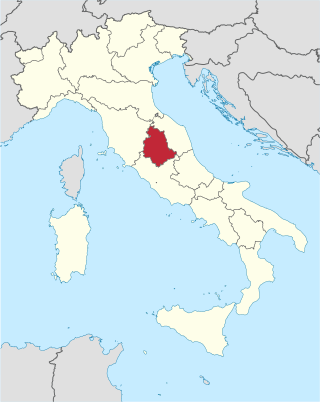
Umbria is a region of central Italy. It includes Lake Trasimeno and Marmore Falls, and is crossed by the Tiber. It is the only landlocked region on the Apennine Peninsula. The regional capital is Perugia.

Perugia is the capital city of Umbria in central Italy, crossed by the River Tiber. The city is located about 164 km (102 mi) north of Rome and 148 km (92 mi) southeast of Florence. It covers a high hilltop and part of the valleys around the area.

Assisi is a town and comune of Italy in the Province of Perugia in the Umbria region, on the western flank of Monte Subasio.

Orvieto is a city and comune in the Province of Terni, southwestern Umbria, Italy, situated on the flat summit of a large butte of volcanic tuff. The city rises dramatically above the almost-vertical faces of tuff cliffs that are completed by defensive walls built of the same stone.

Spoleto is an ancient city in the Italian province of Perugia in east-central Umbria on a foothill of the Apennines. It is 20 km (12 mi) south of Trevi, 29 km (18 mi) north of Terni, 63 km (39 mi) southeast of Perugia; 212 km (132 mi) southeast of Florence; and 126 km (78 mi) north of Rome.
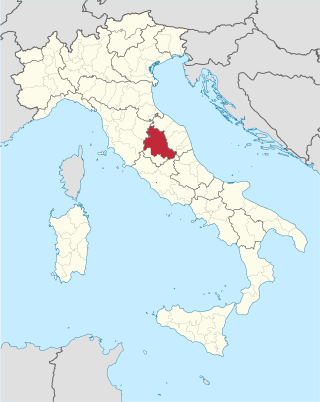
The province of Perugia is the larger of the two provinces in the Umbria region of Italy, comprising two-thirds of both the area and population of the region. Its capital is the city of Perugia. The province covered all of Umbria until 1927, when the province of Terni was carved out of its southern third. The province of Perugia has an area of 6,334 km2 covering two-thirds of Umbria, and a total population of about 660,000. There are 59 comuni in the province. The province has numerous tourist attractions, especially artistic and historical ones, and is home to the Lake Trasimeno, the largest lake of Central Italy. It is historically the ancestral origin of the Umbri, while later it was a Roman province and then part of the Papal States until the late 19th century.

Braccio da Montone, born Andrea Fortebraccio, was an Italian condottiero.
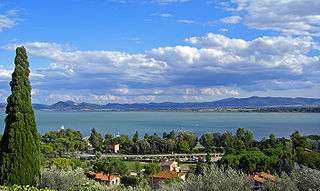
Lake Trasimeno, also referred to as Trasimene or Thrasimene in English, is a lake in the province of Perugia, in the Umbria region of Italy on the border with Tuscany. The lake has a surface area of 128 km2 (49.4 sq mi), making it the fourth largest in Italy, slightly smaller than Lake Como. Only two minor streams flow directly into the Lake and none flows out. The water level of the lake fluctuates significantly according to rainfall levels and the seasonal demands from the towns, villages and farms near the shore.

Bettona is an ancient town and comune of Italy, in the province of Perugia in central Umbria at the northern edge of the Colli Martani range. It is 5 km (3 mi) E of Torgiano and 12 km (7 mi) SW of Assisi. It is one of I Borghi più belli d'Italia. Passaggio, Colle and Cerreto are frazioni of the comune.

Castiglione del Lago is a town in the province of Perugia of Umbria, on the southwest corner of Lake Trasimeno. Orvieto is 59 km (37 mi) south, Chiusi is 21 km (13 mi) to the south west, Arezzo is 56 km (35 mi) to the north west, Cortona is 21 km (13 mi) to the north and Perugia is 47 km (29 mi) to the south east.

Assisi Cathedral, dedicated to San Rufino, is a major church in Assisi, Italy. This stately church in Umbrian Romanesque style was the third church built on the same site to contain the remains of bishop Rufinus of Assisi, martyred in the 3rd century. The construction was started in 1140 to the designs by Giovanni da Gubbio, as attested by the wall inscription visible inside the apse. He may be the same Giovanni who designed the rose-window on the façade of Santa Maria Maggiore in 1163.
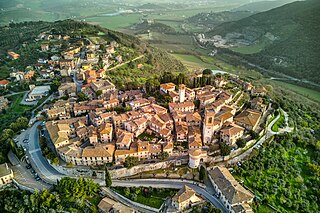
Corciano is a comune (municipality) in the Province of Perugia in the Italian region Umbria, located about 8 km west of Perugia. As of 31 December 2004, it had a population of 17,008 and an area of 63.7 km2. Corciano borders the comuni of Magione and Perugia. It is one of I Borghi più belli d'Italia.

Stroncone is a comune (municipality) in the Province of Terni in the Italian region Umbria, located about 70 km southeast of Perugia and about 8 km south of Terni. It is one of I Borghi più belli d'Italia.

The Castelli di Cannero are three rocky islets of Lake Maggiore in northern Italy. They are located off the shoreline of Cannero Riviera while administratively forming part of the Comune of Cannobio. They are known as castelli, or castles, in recognition of the ruined ancient fortifications which are found on two of them. They are all that remains of the Rocca Vitaliana fortress built between 1519 and 1521 by Ludovico Borromeo, who gave it this name in honour of an illustrious ancestor.
RidolfoII da Varano, signore di Camerino, was a condottiero operating in Italy from the 1360s. His forebears had long held the rocca of Varano on the borderland of the Papal States, controlling a major strategic pass between Umbria and the Marche, a link between Rome and the Adriatic coast. He inherited from Gentile di Berardo da Varano in 1355, and undertook the improvement of the fortifications that protected the commune and its rocca.

Perugia was a long-time papal residence during the 13th century. Five popes were elected here: Pope Honorius III (1216–1227), Pope Clement IV (1265–1268), Pope Honorius IV (1285–1287), Pope Celestine V (1294), and Pope Clement V (1305–1314). These elections took place in the Palazzo delle Canoniche adjoining the Perugia Cathedral.
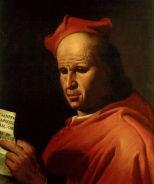
Raniero Capocci, also known as Ranieri, Rainier, or Rainerio da Viterbo was an Italian cardinal and military leader, a fierce adversary of emperor Frederick II.
Civitella d'Arna is a frazione of the comune (municipality) of Perugia in central Italy, and the Ancient city and former bishopric Arna, which remains a Latin Catholic titular see.
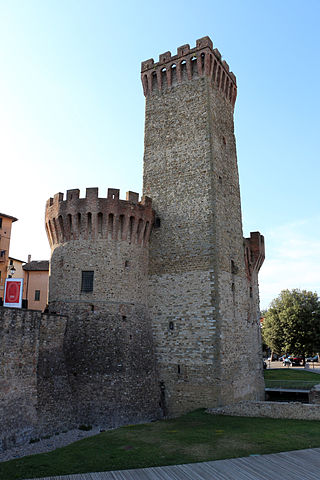
The Rocca of Umbertide is a 14th-century castle located in the center of the town of Umbertide, province of Perugia, region of Umbria, Italy. It is the town's symbol.

The Visconti Rocca of Urgnano, also known as Visconti Castle or Albani Rocca, is a middle age fortification in Urgnano, Lombardy in northern Italy. It was built in 1354 by Giovanni Visconti, Archbishop, and Lord of Milan. Today, it is the property of the Urgnano municipality.